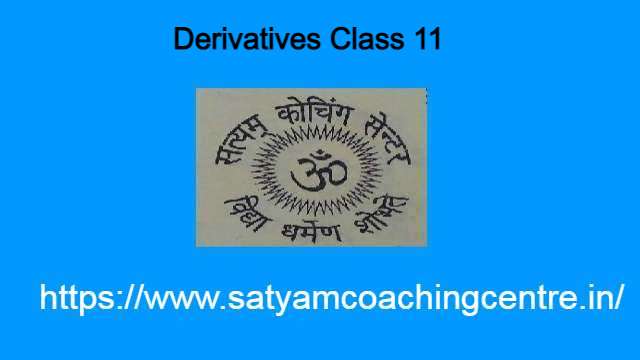Derivatives Class 11
1.अवकलज कक्षा 11 (Derivatives Class 11),अवकलज (Derivatives):
अवकलज कक्षा 11 (Derivatives Class 11) से क्या तात्पर्य है? विविध समयान्तरालों पर पिण्ड की स्थिति को जानकर उस दर को ज्ञात करना सम्भव है जिससे पिण्ड की स्थिति परिवर्तित हो रही है।समय के विविध क्षणों पर एक निश्चित प्राचल (parameter) का जानना और उस दर को ज्ञात करने का प्रयास करना जिससे इसमें परिवर्तन हो रहा है,अत्यन्त व्यापक रुचि का विषय है।वास्तविक जीवन की अनेक स्थितियाँ होती है जिनमें ऐसी प्रक्रिया कार्यान्वित करने की आवश्यकता होती है।ऐसी स्थितियों में यह जानना अभीष्ट होता है कि एक प्राचल में दूसरे किसी प्राचल के सापेक्ष परिवर्तन किस प्रकार होता है? परिणाम के प्रान्त के प्रदत्त बिन्दु पर फलन का अवकलज इस विषय का मुख्य उद्देश्य है।
आपको यह जानकारी रोचक व ज्ञानवर्धक लगे तो अपने मित्रों के साथ इस गणित के आर्टिकल को शेयर करें।यदि आप इस वेबसाइट पर पहली बार आए हैं तो वेबसाइट को फॉलो करें और ईमेल सब्सक्रिप्शन को भी फॉलो करें।जिससे नए आर्टिकल का नोटिफिकेशन आपको मिल सके । यदि आर्टिकल पसन्द आए तो अपने मित्रों के साथ शेयर और लाईक करें जिससे वे भी लाभ उठाए । आपकी कोई समस्या हो या कोई सुझाव देना चाहते हैं तो कमेंट करके बताएं।इस आर्टिकल को पूरा पढ़ें।
Also Read This Article:-Three Dimensional Geometry Class 11
2.अवकलज कक्षा 11 के साधित उदाहरण (Derivatives Class 11 Solved Examples):
Example:1.x=10 पर x^2-2 का अवकलज ज्ञात कीजिए।
Solution:माना f(x)=x^2-2 \\ \frac{d f(x)}{d x}=\underset{h \rightarrow 0}{\lim} \frac{f(x+h)-f(x)}{h} \\ =\underset{h \rightarrow 0}{\lim} \frac{(x+h)^2-2-\left(x^2-2\right)}{h} \\ =\underset{h \rightarrow 0}{\lim} \frac{x^2+2 x h+h^2-2-x^2+2}{h} \\ =\underset{h \rightarrow 0}{\lim} \frac{2 x h+h^2}{h} \\ =\underset{h \rightarrow 0}{\lim} \frac{h(2 x+h)}{h} \\ =\underset{h \rightarrow 0}{\lim}(2 x+h) \\ \frac{d f(x)}{d x}=2 x \\ \Rightarrow \frac{d f(20)}{d x}=2 \times 10=20
Example:2.x=100 पर 99x का अवकलज ज्ञात कीजिए।
Solution:माना f(x)=99 x \\ \frac{d f(100)}{d x} =\underset{h \rightarrow 0}{\lim} \frac{f(100+h)-f(100)}{h} \\ =\underset{h \rightarrow 0}{\lim} \frac{99(100+h)-99 \times 100}{h} \\ =\underset{h \rightarrow 0}{\lim} \frac{9900+99 h-9900}{h} \\ =\underset{h \rightarrow 0}{\lim} \frac{99 h}{h} \\ =\underset{h \rightarrow 0}{\lim}(99) \\ \Rightarrow \frac{d f(100)}{d x} =99
Example:3.x=1 पर x का अवकलज ज्ञात कीजिए।
Solution:माना y=f(x)=x \\ \left(\frac{d y}{d x}\right)_{(x=1)} =\underset{h \rightarrow 0}{\lim} \frac{f(1+h)-f(1)}{h} \\ =\underset{h \rightarrow 0}{\lim} \frac{(1+h)-1}{h} \\ =\underset{h \rightarrow 0}{\lim} \frac{1+h-1}{h} \\ =\underset{h \rightarrow 0}{\lim} \left(\frac{h}{h}\right) \\ =\underset{h \rightarrow 0}{\lim} (1) \\ \left(\frac{d y}{d x}\right)_{(x=1)} =1
Example:4.प्रथम सिद्धान्त से निम्नलिखित फलनों के अवकलज ज्ञात कीजिएः
Example:4(i). x^2-27
Solution:माना f(x)=x^2-27 \\ f^{\prime}(x) =\underset{h \rightarrow 0}{\lim} \frac{f(x+h)-f(x)}{h} \\=\underset{h \rightarrow 0}{\lim} \frac{(x+h)^3-\left(x^3-27\right)-27}{h} \\ =\underset{h \rightarrow 0}{\lim} \frac{x^3+3 x^2 h+h^3-x^3+27-27+3 x h^{2}}{h} \\=\underset{h \rightarrow 0}{\lim} \frac{3 x^2 h+h^3+3 x h^2}{h} \\ =\underset{h \rightarrow 0}{\lim} \frac{h\left(3 x^2+h^2+3 x h\right)}{h} \\ =4 \underset{h \rightarrow 0}{\lim} \left(3 x^2+h^2+3 x h\right) \\ =3 x^2 \\ \Rightarrow f^{\prime}(x) =3 x^2
Example:4(ii).(x-1)(x-2)
Solution:माना y=x^2-3 x+2 \\ \frac{dy}{dx}=\underset{h \rightarrow 0}{\lim} \frac{f(x+h)-f(x)}{h} \\ =\underset{h \rightarrow 0}{\lim} \frac{(x+h)^2-3(x+h)+2-\left(x^2-3 x+2\right)}{h} \\ =\underset{h \rightarrow 0}{\lim} \frac{x^2+2 x h+h^2-3 x-3 h+2-x^2+3 x-2}{h} \\ =\underset{h \rightarrow 0}{\lim} \frac{2 x h+h^2-3 h}{h} \\ =\underset{h \rightarrow 0}{\lim} \frac{h(2 x+h-3)}{h} \\=\underset{h \rightarrow 0}{\lim} (2 x+h-3) \\ \Rightarrow \frac{d y}{d x} =2 x-3
Example:4(iii). \frac{1}{x^2}
Solution:माना f(x)=y=\frac{1}{x^2} \\ \frac{d y}{d x}=\underset{h \rightarrow 0}{\lim} \frac{f(x+h)-f(x)}{h} \\ =\underset{h \rightarrow 0}{\lim} \frac{\frac{1}{(x+h)^2}-\frac{1}{x^2}}{h} \\ =\underset{h \rightarrow 0}{\lim} \frac{x^2-(x+h)^2}{h x^2(x+h)^2} \\= \underset{h \rightarrow 0}{\lim} \frac{x^2-x^2-2 x h-h^2}{h x^2(x+h)^2} \\ =\underset{h \rightarrow 0}{\lim} \frac{-h(2 x+h)}{h x^2(x+h)^2} \\ =\underset{h \rightarrow 0}{\lim} \frac{-(2 x+h)}{x^2\left(x+h\right)^{2}} \\ =\frac{-2 x}{x^4} \\ \Rightarrow \frac{d y}{d x} =-\frac{2}{x^3}
Example:4(iv). \frac{x+1}{x-1}
Solution:माना f(x)=y=\frac{x+1}{x-1} \\ \frac{d y}{d x}=\underset{h \rightarrow 0}{\lim} \frac{f(x+h)-f(x)}{h} \\ =\underset{h \rightarrow 0}{\lim} \frac{\frac{x+h+1}{x+h-1}-\frac{x+1}{x-1}}{h} \\ =\underset{h \rightarrow 0}{\lim} \frac{(x-1)(x+h+1)-(x+h-1)(x+1)}{h(x+h-1)(x-1)} \\ =\underset{h \rightarrow 0}{\lim} \frac{x^2+x h+x-x-h-1-\left(x^2+x+h x+h-x-1\right)}{h(x+h-1)(x-1)} \\ =\underset{h \rightarrow 0}{\lim} \frac{x^2+xh-h-1-x^{2}-hx-h+1}{h(x+h-1)(x-1)} \\ =\underset{h \rightarrow 0}{\lim} \frac{-2 h}{h(x+h-1)(x-1)} \\ =\underset{h \rightarrow 0}{\lim} \frac{-2}{(x+h-1)(x-1)} \\ \Rightarrow \frac{d y}{d x}= \frac{-2}{(x-1)^2}
Example:5.फलन f(x)=\frac{x^{100}}{100}+\frac{x^{99}}{99}+\ldots \ldots+\frac{x^2}{2}+x+1 के लिए सिद्ध कीजिए कि f'(1)=100 f'(0).
Solution: f(x)=\frac{x^{100}}{100}+\frac{x^{99}}{99}+\ldots \ldots+\frac{x^2}{2}+x+1 \\ f^{\prime}(x)=\frac{100 x^{99}}{100}+\frac{99 x^{98}}{99}+\cdots+\frac{2 x}{2}+1 \\ \Rightarrow f^{\prime}(x)= x^{99}+x^{98}+\cdots+x+1 \\ \Rightarrow f^{\prime}(1)=(1)^{99}+1^{98}+\cdots+1+1 \\ \Rightarrow f^{\prime}(1)=100 \\ f^{\prime}(0)=0^{99}+0^{98}+\cdots+0^{0}+1 \\ f^{\prime}(0)=1 \\ \Rightarrow f^{\prime}(1)=100 f^{\prime}(0)=100
Example:6.किसी अचर वास्तविक संख्या a के लिए f(x)=x^n+a x^{n-1}+a^2 x^{n-2}+\ldots \ldots+a^{n-1} x+a^{n} का अवकलज ज्ञात कीजिए।
Solution:माना f(x)=x^n+a x^{n-1}+a^2 x^{n-2}+\ldots \ldots+a^{n-1} x+a^{n} \\ f^{\prime}(x)=n x^{n-1}+a(n-1) x^{n-2}+a^2(n-2) x^{n-3}+\ldots+a^{n-1}
Example:7.किन्हीं अचरों a और b के लिए
(i) (x-a)(x-b)
(ii)\left(a x^2+b\right)^2
(iii)\frac{x-a}{x-b}
Example:7(i).(x-a)(x-b)
Solution:माना f(x)=x^2-(a+b) x+ab \\ f^{\prime}(x)=\underset{h \rightarrow 0}{\lim} \frac{f(x+h)-f(x)}{h} \\ =\underset{h \rightarrow 0}{\lim} \frac{(x+h)^2-a(x+h)-b(x+h)+a b-\left[x^2-(a+b) x+a b\right]}{h} \\ =\underset{h \rightarrow 0}{\lim} \frac{x^2+2 x h+h^2-a x-a h-b x-b h+a b-x^2+a x+b x-ab}{h}\\ =\underset{h \rightarrow 0}{\lim} \frac{2 x h+h^2-a h-b h}{h} \\ =\underset{h \rightarrow 0}{\lim} \frac{h(2 x+h-a-b)}{h}\\ \Rightarrow f^{\prime}(x)=2 x-a-b
Example:7(ii). \left(a x^2+b\right)^2
Solution:माना f(x)=\left(a x^2+b\right)^2 \\ \Rightarrow f(x)=a^2 x^4+2 a b x^2+b^2 \\ f^{\prime}(x)=\underset{h \rightarrow 0}{\lim} \frac{f(x+h)-f(x)}{h} \\ =\underset{h \rightarrow 0}{\lim} \frac{ a^2 (x+b)^4+2 a b(x+h)^2+b^2-\left(a^2 x^4+2 a b x^2+b^2\right)}{h} \\ =\underset{h \rightarrow 0}{\lim} \frac{a^2 x^4+4 a^2 x^3 h+6 a^2 x^{2} h^2 +4 a^2 x h^3+a^2 h^4+2 a b x^2+4 a b x h+2 a b h^2 +b^2 -a^2 x^4-2 a b x^2-b^2}{h}\\ =\underset{h \rightarrow 0}{\lim} \frac{4 a^2 x^3 h+6 a^2 x^2 h^2+4 a^2 x h^2+a^2 h^3+4abx+2abh}{h} \\ =\underset{h \rightarrow 0}{\lim} \frac{h\left[4 a^2 x^3+6 a^2 x^2 h+4 a^2 x h^2+a^2 h^3+4 a b x+2 abh\right]}{h} \\ \Rightarrow f^{\prime}(x)=4 a^2 x^3+4 a b x \\ \Rightarrow f^{\prime}(x)=4 a x\left(a x^2+b\right)
Example:7(iii). \frac{x-a}{x-b}
Solution:माना f(x)=\frac{x-a}{x-b}
भागफल नियम सेः
\frac{d f(x)}{d x}=\frac{d}{d x}\left(\frac{x-a}{x-b}\right)
माना u=x-a,v=x-b
f^{\prime}(x)=\frac{u^{\prime} v-u v^{\prime}}{v^2} \text{ से }\\ =\frac{(x-a)^{\prime}(x-b)-(x-a)(x-b)^{\prime}}{(x-b)^2} \\ =\frac{1 \cdot(x-b)-(x-a) \cdot 1}{(x-b)^2} \\ =\frac{x-b-x+a}{(x-b)^2} \\ \Rightarrow f^{\prime}(x) =\frac{a-b}{(x-b)^2}
Example:8.किसी अचर a के लिए का अवकलज ज्ञात कीजिए।
Solution:माना f(x)=\frac{x^n-a^n}{x-a}
माना x^n-a^n=u, x-a=v
भागफल नियम सेः
\frac{d}{d x}\left(\frac{u}{v}\right)=\frac{u^{\prime} v-u v^{\prime}}{v^2} \\ \Rightarrow f^{\prime}(x)=\frac{(x-a) \frac{d}{d x}\left(x^n-a^n\right)-\left(x^n-a^n\right) \cdot 1}{(x-a)^2} \\ =\frac{(x-a)\left(n x^n-1\right)-\left(x^n-a^n\right)}{(x-a)^2} \\ =\frac{(x-a) n x^{n-1}-x^n+a^n}{(x-a)^2} \\ \Rightarrow f^{\prime}(x) =\frac{n x^n-a n x^{n-1}-x^n+a^n}{(x-a)^2}
Example:9.निम्नलिखित के अवकलज ज्ञात कीजिए।
Example:9(i). 2 x-\frac{3}{4}
Solution:माना y=2 x-\frac{3}{4} \\ \frac{d y}{d x}=2
Example:9(ii). \left(5 x^3+3 x-1\right)(x-1)
Solution:माना y=\left(5 x^3+3 x-1\right)(x-1)
Leibnitz गुणन सूत्र से
\frac{d y}{d x} =\left(5 x^3+3 x-1\right)(x-1)^{\prime}+\left(5 x^3+3 x-1\right)^{\prime}(x-1) \\ =\left(5 x^3+3 x-1\right) \cdot 1+\left(15 x^2+3\right)(x-1) \\ =5 x^3+3 x-1+15 x^3-15 x^2+3 x-3 \\ \frac{d y}{d x}=20 x^3-15 x^2+6 x-4
Example:9(iii). x^{-3}(5+3 x)
Solution:माना y=x^{-3}(5+3 x)
Leibnitz गुणन सूत्र सेः
\frac{d y}{d x} =x^{-3}(5+3 x)^{\prime}+\left(x^{-3}\right)^{\prime} (5+3 x) \\ =x^{-3}(3)-3 x^{-4}(5+3 x) \\ =3 x^{-3}-15 x^{-4}-9 x^{-3} \\ =\frac{3}{x^3}-\frac{15}{x^4}-\frac{9}{x^3} \\ =\frac{3 x-15-9 x}{x^4} \\ \Rightarrow \frac{d y}{d x} =-\frac{3}{x^4}(5+2 x)
Example:9(iv). x^5\left(3-6 x^{-9}\right)
Solution:माना y=x^5\left(3-6 x^{-9}\right)
Leibnitz गुणन सूत्र सेः
\frac{d y}{d x} =x^5\left(3-6 x^{-9}\right)^{\prime}+\left(x^5\right)^{\prime}\left(3-6 x^{-9}\right) \\ =x^5\left(54 x^{-10}\right)+5 x^4\left(3-6 x^{-9}\right) \\ =54 x^{-5}+15 x^4-30 x^{-5} \\ =24 x^{-5}+15 x^4 \\ \Rightarrow \frac{d y}{d x}=15 x^4+\frac{24}{x^5}
Example:9(v). x^{-4}\left(3-4 x^{-5}\right)
Solution:माना y=x^{-4}\left(3-4 x^{-5}\right)
Leibnitz गुणन सूत्र सेः
\frac{d y}{d x} =x^{-4}\left(3-4 x^{-5}\right)^{\prime}+\left(x^{-4}\right)^{\prime}\left(3-4 x^{-5}\right) \\ =x^{-4}\left(20 x^{-6}\right)-4 x^{-5}\left(3-4 x^{-5}\right) \\ =20 x^{-10}-12 x^{-5}+16 x^{-10} \\ \Rightarrow \frac{d y}{d x}=-\frac{12}{x^5}+\frac{36}{x^{10}}
Example:9(vi). \frac{2}{x+1}-\frac{x^2}{3 x-1}
Solution:माना f(x)=\frac{2}{x+1}-\frac{x^2}{3 x-1}
भागफल सूत्र \frac{d}{d x}\left(\frac{u}{v}\right)=\frac{u^{\prime} v-u v^{\prime}}{v^2} सेः
f^{\prime}(x)=\frac{(x+1)(2)^{\prime}-2(x+1)^{\prime}}{(x+1)^2}-\frac{\left[(3 x1)\left( x^2\right)^{\prime}- x^2(3 x-1)^2\right]}{(3 x-1)^{2}} \\ =\frac{(x+1)(0)-2(1)}{(x+1)^2}-\frac{\left[(3 x-1) \cdot 2 x-x^2 \cdot (3)\right]}{(3 x-1)^2} \\ =-\frac{2}{(x+1)^2}-\frac{6 x^2-2 x-3 x^2}{(3 x-1)^2} \\ f^{\prime}(x)=\frac{-2}{(x+1)^2}-\frac{x(3 x-2)}{(3 x-1)^2}
Example:10.प्रथम अवकलज से \cos x का अवकलज ज्ञात कीजिए।
Solution:माना कि y=\cos x \cdots(1) \\ y+\delta y=\cos (x+3 x) \cdots(2)
समीकरण (2) में से (1) घटाने परः
\delta y =\cos (x+\delta x)-\cos x \\ =2 \sin \left(\frac{x+\delta x+x}{2}\right) \sin \left(\frac{x-x-\delta x}{2}\right) \\=2 \sin \left(x+\frac{\delta x}{2}\right) \sin \left ( -\frac{\delta x}{2} \right )
दोनों पक्षों को से भाग देने परः
\frac{\delta y}{\delta x}=-2 \sin \left(x+\frac{\delta x}{2}\right) \frac{\sin \frac{\delta x}{2}}{\delta x} \\ \therefore \underset{\delta x \rightarrow 0}{\lim} \frac{\delta y}{\delta x}=\underset{\delta x \rightarrow 0}{\lim} -\sin \left(x+\frac{\delta x}{2} \right) \underset{\delta x \rightarrow 0}{\lim} \frac{\sin \left(\frac{\delta x}{2}\right)}{\left(\frac{\delta x}{2}\right)}\\ =-\sin x \cdot (1) \\ \Rightarrow \frac{d y}{d x}=-\sin x \\ \Rightarrow \frac{d}{d x}(\cos x)=-\sin x
Example:11.निम्नलिखित फलनों के अवकलज ज्ञात कीजिए।
Example:11(i). \sin x \cos x
Solution:माना f(x)=\sin x \cos x
Leibnitz के गुणन नियम सेः
f(x)=\sin x \cos x \\ \frac{d f(x)}{d x} =\frac{d}{d x}(\sin x \cos x) \\ =(\sin x)^{\prime} \cos x+\sin x \left(\cos x\right)^{\prime} \\ =\cos x \cdot \cos x+\sin x(-\sin x) \\ \Rightarrow \frac{d f(x)}{d x} =\cos ^2 x-\sin ^2 x \\ \Rightarrow \frac{d f(x)}{d x}=\cos 2 x
Example:11(ii). \sec x
Solution:माना y=\sec x \\ f(x)=y=\frac{1}{\cos x} \\ \frac{d y}{d x} =\underset{h \rightarrow 0}{\lim} \frac{f(x+h)-f(x)}{h} \\ =\underset{h \rightarrow 0}{\lim} \frac{\frac{1}{\cos (x+h)}-\frac{1}{\cos x}}{h} \\ =\underset{h \rightarrow 0}{\lim} \frac{\cos x-\cos (x+h)}{h \cos x \cos (x+h)} \\ =\underset{h \rightarrow 0}{\lim} \frac{2 \sin \left(\frac{x+x+h}{2}\right) \sin \left(\frac{x+h-x}{2}\right)}{h \cos (x+h) \cos x } \\ \frac{d y}{d x} =\underset{h \rightarrow 0}{\lim} \frac{\sin \left(x+\frac{h}{2}\right)}{\cos x \cos (x+h)} \underset{h \rightarrow 0}{\lim} \frac{\sin \left(\frac{h}{2}\right)}{\left(\frac{h}{2}\right)} \\ =\frac{\sin x}{\cos x \cdot \cos x} \times (1) \\ \Rightarrow \frac{d y}{d x}=\sec x \tan x
Example:11(iii). 5 \sec x+4 \cos x
Solution:माना y=5 \sec x+4 \cos x \\ \frac{d y}{d x}=5 \frac{d}{d x}(\sec x)+4 \frac{d}{d x}(\cos x) \\ \Rightarrow \frac{d y}{d x}=5 \sec x \tan x-4 \sin x
Example:11(iv). \operatorname{cosec} x
Solution:माना f(x)=\operatorname{cosec} x \\ f^{\prime}(x)=\underset{h \rightarrow 0}{\lim} \frac{\frac{1}{\sin (x+h)}-\frac{1}{\sin x}}{h} \\ =\underset{h \rightarrow 0}{\lim} \frac{\sin x-\sin (x+h)}{h \sin x \sin (x+h)} \\ =\underset{h \rightarrow 0}{\lim} \frac{2 \cos \left(\frac{x+x+h}{2}\right) \sin \left(\frac{x-x-h)}{2}\right)}{h \sin x \sin (x+h)} \\ =\underset{h \rightarrow 0}{\lim} \frac{2 \cos \left(x+\frac{h}{2}\right) \sin \left(-\frac{h}{2}\right)}{h \sin x \sin (x+h)} \\ =\underset{h \rightarrow 0}{\lim} -\frac{\cos (x+\frac{h}{2})}{\sin x \sin (x+h)} \cdot \underset{h \rightarrow 0}{\lim} \frac{\sin \frac{h}{2}}{\frac{h}{2}} \\ =\frac{-\cos x}{\sin x \cdot \sin x} \times 1 \\ \Rightarrow f^{\prime}(x)=-\operatorname{cosec} x \cot x
Example:11(v). 3 \cot x+5 \operatorname{cosec} x
Solution:माना f(x)=3 \cot x+5 \operatorname{cosec} x \\ \Rightarrow f(x)=\frac{3 \cos x}{\sin x}+\frac{5}{\sin x}
भागफल नियम f\left(\frac{u}{v}\right)=\frac{u^{\prime} v-u v^{\prime}}{v^2} सेः
f^{\prime}(x)=\frac{3 \sin x \frac{d}{d x}(\cos x)-3 \cos x \frac{d}{d x}(\sin x)}{\sin ^2 x} +\frac{\sin x \frac{d}{d x}(5)-5 \frac{d}{d x}(\sin x)}{\sin ^2 x} \\ =\frac{-3 \sin x \sin x-3 \cos x \cdot \cos x}{\sin ^2 x} +\frac{\sin x(0)-5 \cos x}{\sin ^2 x} \\ \Rightarrow f^{\prime}(x)= \frac{-3\left(\sin ^2 x+\cos ^2 x\right)}{\sin ^2 x} +\frac{5 \cos x}{\sin ^2 x} \\ \Rightarrow f^{\prime}(x)=-3 \operatorname{cosec}^2 x-5 \operatorname{cosec} x \cot x
Example:11(vi). 5 \sin x-6 \cos x+7
Solution:माना y=5 \sin x-6 \cos x+7 \\ \frac{d y}{d x} =\frac{d}{d x}(5 \sin x-6 \cos x+7) \\ =5 \cos x+6 \sin x \\ \Rightarrow \frac{d y}{d x} =5 \cos x+6 \sin x
Example:11(vii). 2 \tan x-7 \sec x
Solution:माना f(x)=2 \tan x-7 \sec x \\ \Rightarrow f(x)=2 \frac{\sin x}{\cos x}-\frac{7}{\cos x} \\ f^{\prime}(x)=\frac{2 \cos x \frac{d}{d x} \sin x-2 \sin x \frac{d}{d x}(\cos x)}{\cos ^2 x} \\ =\frac{-\left[\cos x \frac{d}{d x}(7)-7 \frac{d}{d x} \cos x\right]}{\cos ^2 x} \\ = \frac{2 \cos x \cdot \cos x-2 \sin x(-\sin x)}{\cos ^2 x}-\frac{[\cos x \cdot (0)-7(-\sin x)]}{\cos ^2 x} \\=\frac{2 \cos ^2 x+2 \sin ^2 x}{\cos ^2 x}-\frac{7 \sin x}{\cos ^2 x} \\ =\frac{2\left(\cos ^2 x+\sin ^2 x\right)}{\cos ^2 x}-7 \frac{\sin x}{\cos x} \cdot \frac{1}{\cos x} \\ =\frac{2(1)}{\cos ^2 x}-7 \tan x \sec x \\ \Rightarrow f^{\prime}(x) =2 \sec ^2 x-7 \sec x \tan x
उपर्युक्त उदाहरणों के द्वारा अवकलज कक्षा 11 (Derivatives Class 11),अवकलज (Derivatives) को समझ सकते हैं।
3.अवकलज कक्षा 11 की समस्याएँ (Derivatives Class 11 Problems):
निम्न फलनों का प्रथम सिद्धान्त से अवकलन कीजिएः
(1.) \sqrt{\cot x}
(2.) \log_e(a x+b)
निम्न फलनों का x के सापेक्ष अवकलन कीजिएः
(3.) \frac{\sec x-1}{\sec x+1}
(4.) \frac{1+\log _e x}{1-\log _e x}
उत्तर (Answers): (1.) \frac{-\operatorname{cosec}^2 x}{2 \sqrt{\cot x}(2)}
(2.) \frac{a}{a x+b}
(3.) \frac{2 \sin x}{(1+\cos x)^2}
(4.) \frac{2}{x\left(1-\log _e x\right)^2}
उपर्युक्त सवालों को हल करने पर अवकलज कक्षा 11 (Derivatives Class 11),अवकलज (Derivatives) को ठीक से समझ सकते हैं।
Also Read This Article:-Limits Class 11
4.अवकलज कक्षा 11 (Frequently Asked Questions Related to Derivatives Class 11),अवकलज (Derivatives) से सम्बन्धित अक्सर पूछे जाने वाले प्रश्न:
प्रश्न:1.एक वास्तविक मानीय फलन का सूत्र लिखो। (Write Formula of Single Real Valued Function):
उत्तर:मान लीजिए f एक वास्तविक मानीय फलन है और इसकी परिभाषा के प्रान्त में एक बिन्दु a है।a पर f का अवकलज
\underset{h \rightarrow 0}{\lim} \frac{f(a+h)-f(a)}{h}
से परिभाषित है बशर्ते कि इस सीमा का अस्तित्व हो।a पर f(x) का अवकलज f'(a) निरूपित होता है।f'(a), a पर x के सापेक्ष परिवर्तन का परिमाण बताता है।
प्रश्नः2.अवकलज का प्रथम सिद्धान्त क्या है? (What is First Principle of Derivatives?):
उत्तर:मान लीजिए कि f एक वास्तविक मानीय फलन है तो
\underset{h \rightarrow 0}{\lim} \frac{f(x+h)-f(x)}{h}
से परिभाषित फलन,जहाँ कहीं सीमा का अस्तित्व है, को x पर f का अवकलज परिभाषित किया जाता है और f(x) से निरूपित किया जाता है।अवकलज की इस परिभाषा को प्रथम सिद्धान्त भी कहा जाता है।
इस प्रकार
f^{\prime}(x)=\underset{h \rightarrow 0}{\lim} \frac{f(x+h)-f(x)}{h}
स्पष्टतः f'(x) की परिभाषा का प्रान्त वही है जहाँ कहीं उपर्युक्त सीमा का अस्तित्व है।एक फलन के अवकलज के विभिन्न संकेतन हैं।कभी-कभी f'(x) को \frac{d}{d x} (f(x)) से निरूपित किया जाता है यदि y=f(x) तो यह \frac{dy}{d x} से निरूपित किया जाता है।इसे y या f(x) के सापेक्ष अवकलज के रूप में उल्लेखित किया जाता है इसे D(f(x)) से भी निरूपित किया जाता है।
इसके अतिरिक्त x=a पर f के अवकलज को \left.\frac{d}{d x} f(x)\right|_{a} या \left.\frac{d f}{d x}\right|_{a} या \left(\frac{d f}{d x}\right)_{x=0} से भी निरूपित किया जाता है।
प्रश्न:3.फलनों के अवकलज का बीजगणित के बारे में बताएं। (Explain Algebra of Derivative of Functions):
उत्तर:मान लीजिए f और g दो ऐसे फलन हैं कि उनके उभयनिष्ठ प्रान्त में उनके अवकलन परिभाषित हैं, तब
(i)दो फलनों के योग का अवकलज उन फलनों के अवकलजों का योग है।
\frac{d}{d x}[f(x)+g(x)]=\frac{d}{d x} f(x)+\frac{d}{d x} g(x)
(ii)दो फलनों के अन्तर का अवकलज उन फलनों के अवकलजों का अन्तर है।
\frac{d}{d x}[f(x)-g(x)]=\frac{d}{d x} f(x)-\frac{d}{d x} g(x)
(iii)दो फलनों के गुणन का अवकलज निम्नलिखित गुणन नियम (product rule) से दिया गया हैः
\frac{d}{d x}[f(x) \cdot g(x)]=\frac{d}{d x} f(x) \cdot g(x)+f(x) \cdot \frac{d}{d x} g(x)
(iv)दो फलनों के भागफल का अवकलज निम्नलिखित भागफल नियम (quotient rule) से दिया गया है (जहाँ कहीं हर शून्येतर है)
\frac{d}{d x}\left(\frac{f(x)}{g(x)}\right)=\frac{ \frac{d}{d x} f(x) \cdot g(x)-f(x) \frac{d}{d x}(x)}{(g(x))^2}
उपर्युक्त के अन्तिम दो कथनों को निम्नलिखित ढंग से पुनः कहा जा सकता हैः
मान लीजिए u=f(x) और v=g(x) तब
(uv)’=u’v+uv’
यह फलनों के गुणन के अवकलन के लिए Leibnitz नियम या गुणन नियम उल्लेखित होता है।
इसी प्रकार भागफल नियम है
\left(\frac{u}{v}\right)^{\prime}=\frac{u^{\prime} v-u v^{\prime}}{v^2}
प्रश्न:4.बहुपदों और त्रिकोणमितीय फलनों के अवकलज कैसे ज्ञात करते हैं? (How Do You Find the Derivative of Polynomials and Trigonometric Functions?):
उत्तर:मान लीजिए कि f(x)=a_n x^n+a_{n-1} x^{n-1}+\ldots+a_1 x+a_0
एक बहुपदीय फलन है जहाँ a_{i}s सभी वास्तविक संख्याएँ हैं और a_n \neq 0 तब अवकलज फलन इस प्रकार दिया जाता हैः
\frac{d f(x)}{d x}=n a_n x^{n-1}+(n-1) a_{n-1} x^{n-2}+\ldots \ldots+ 2 a_2 x+a_1
उपर्युक्त प्रश्नों के उत्तर द्वारा अवकलज कक्षा 11 (Derivatives Class 11),अवकलज (Derivatives) के बारे में ओर अधिक जानकारी प्राप्त कर सकते हैं।
| No. | Social Media | Url |
|---|---|---|
| 1. | click here | |
| 2. | you tube | click here |
| 3. | click here | |
| 4. | click here | |
| 5. | Facebook Page | click here |
| 6. | click here |
Derivatives Class 11
अवकलज कक्षा 11 (Derivatives Class 11)
Derivatives Class 11
अवकलज कक्षा 11 (Derivatives Class 11) से क्या तात्पर्य है? विविध समयान्तरालों पर पिण्ड की
स्थिति को जानकर उस दर को ज्ञात करना सम्भव है जिससे पिण्ड की स्थिति परिवर्तित हो रही है।
Related Posts
About Author
Satyam
About my self I am owner of Mathematics Satyam website.I am satya narain kumawat from manoharpur district-jaipur (Rajasthan) India pin code-303104.My qualification -B.SC. B.ed. I have read about m.sc. books,psychology,philosophy,spiritual, vedic,religious,yoga,health and different many knowledgeable books.I have about 15 years teaching experience upto M.sc. ,M.com.,English and science.








